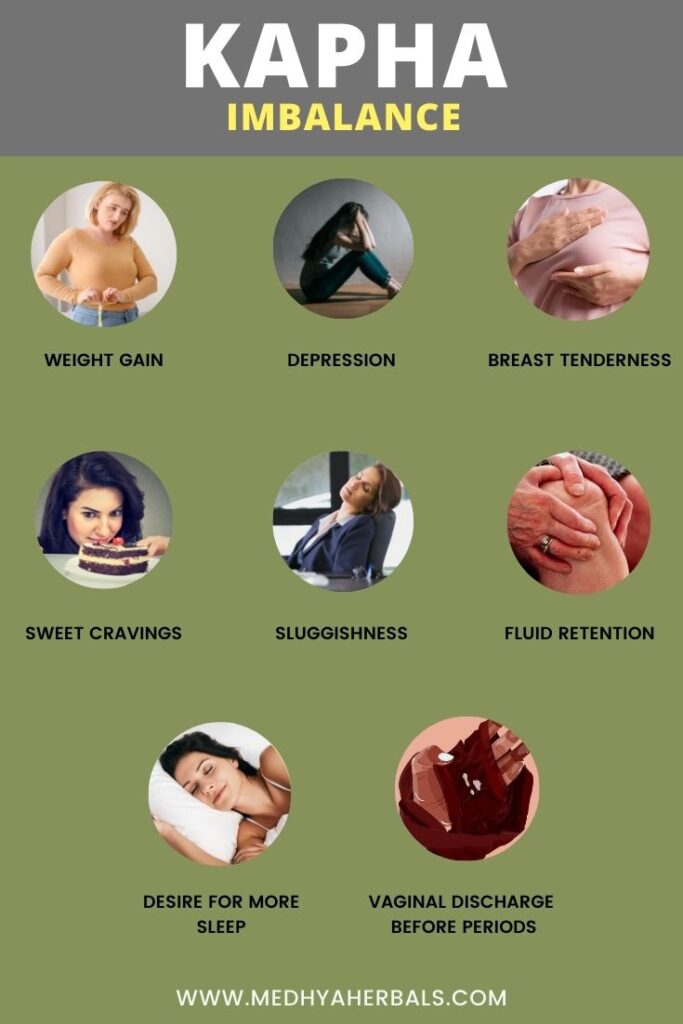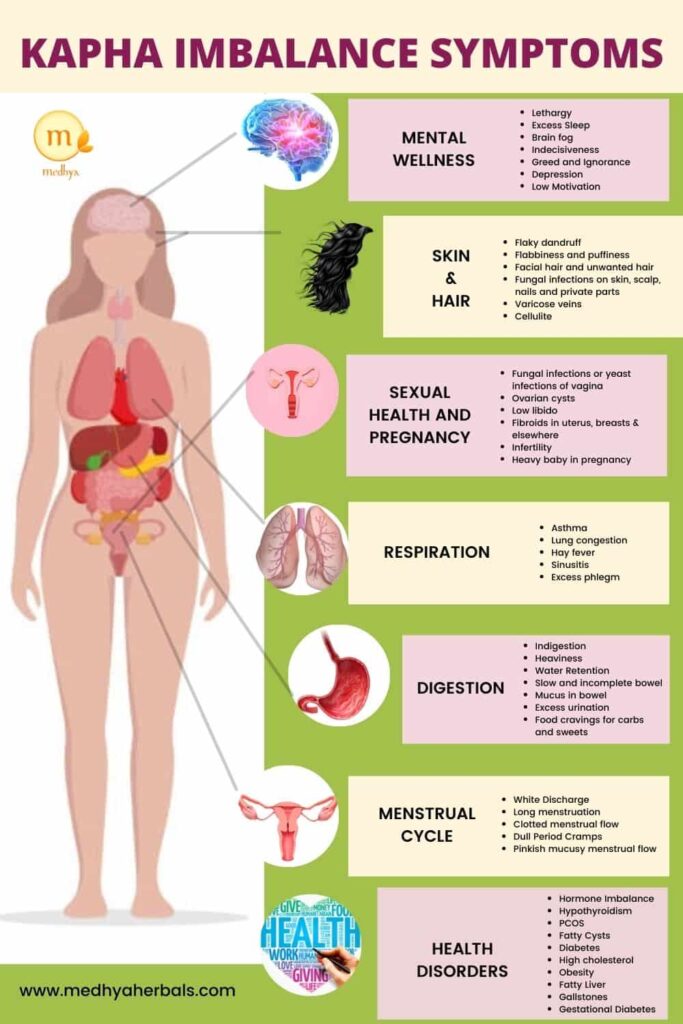Kapha Imbalance triggers inertia, blockade, and sluggishness in the body and mind. Usually, Kapha Dosha increases in damp and cold weathers and by taking in heavy meals.
Kapha is the energy of growth and structure. That’s why when one experiences kapha imbalance, they often struggle with symptoms related to excess in the body.
Some of the health symptoms of kapha imbalance are lethargy, depression, water retention, sinus congestion, metabolic disorders, and fungal infections.
In this post you will learn about the causes and symptoms of kapha imbalance. We will also look into kapha dosha pacifying diet, yoga and lifestyle routine to balance your health in the Ayurvedic way!
1. Signs of Kapha Imbalance in the Mind
- Lethargy, Excessive sleep and lack of energy despite enough resting hours.
- Depression, withdrawal, lack of interest in life and activities, absence of motivation.
- Drowsiness, brain fog, indecisiveness, and lack of clarity.
- Greed, possessiveness, ignorance, and excessive attachment.
2. Health Issues of Kapha Imbalance in Men
- Premature ejaculation (emotional)
- Enlarged prostate
- Cold and heavy testicles
3. Health Issues of Kapha Imbalance in Women
- Fungal and yeast infections in the vagina.
- Ovarian cysts, fibrocystic lumps, and fatty cysts on the skin or breasts.
- Polycystic Ovarian Syndrome.
- Hypothyroidism
- Excessive vaginal discharge that is mucoid, white, milky, and without foul smell.
- Prolonged and slow menstrual cycles.
- Low libido.

4. Kapha Imbalance leads to Diabetes, Obesity and High Cholesterol
- Early signs of kapha increase include a sense of heaviness, nausea, excessive salivation, sweet taste in the mouth, indigestion, sluggish metabolism, and low or no appetite.
- Kapha imbalance causes the stools to be heavy, oily, pale, sticky, and mucoid.
- Usually a feeling of incomplete bowel movement is present. Kapha increase can lead to mucoid diarrhoea or runny stools.
- Chronic kapha imbalance triggers high blood sugar levels, Diabetes, eating disorders, and pus in the stools.
- Excessive kapha is also indicated by high triglyceride levels, high cholesterol levels, artery stiffening, and symptoms of atherosclerosis.
- Kapha imbalance leads to fatty liver, enlarged liver, and enlarged spleen.
5. Fungal Infections and Excessive Body Wastes
- Excessive urination, excess ear wax, dental tartar, and excessive hair growth.
- Excessive desire for pleasure in the form of sweet foods, treats, indulgence, and sex.
- Kapha imbalance can lead to whiteness in the urine, eyes, or feces,
- It can lead to the growth of tumors, goiter, glaucoma, protruded eyes, and gallstones.
- Fungal and yeast infections across various body parts such as skin, scalp, nails, and private parts.
6. Kapha Imbalance causes Swelling and Water Retention
- High fluid retention that is localized to mouth, tongue, nose, respiratory system, stomach, spleen, around the heart, and where there is a protective sack, nails, and hair.
- Lymphatic congestion, swollen lymph glands, varicose veins with thrombus, and deep vein thrombosis.
- Profuse edema, solid edema, and formation of malignant fatty tumors such as liposarcomas.
- High blood pressure due to fluid retention, and or weight gain.
- Pallor, Cold sweats, reduced or no sweating, and loss of strength.
- Swelling and stiffness in the joints and a sense of heaviness in the body.
7. Kapha Imbalance leads to Asthma, Sinus blockage, and Excessive Mucus
- Kapha increase affects the respiratory system through excessive production and accumulation of mucus.
- Colds, productive cough with phlegm, a runny nose, excess nasal crust, chronic or short sinus infections, and phlegm adhered to the throat.
- Hay fever, flu, wheezing, congestion in the sinuses, throat, and chest.
- Cystic fibrosis in lungs, Asthma, and Bronchitis.
8. Kapha Imbalance leads to Slow Digestion
An individual with Kapha Dosha Imbalance suffers from poor digestive fire. This results in sluggish movement of food through the digestive tract, low levels of hunger, and insufficient digestion.
In Ayurveda, Kapha type of digestion is called Manda Agni
A sluggish digestion leads to build up of wastes and toxins in the body. This triggers multiple health problems related to inflammation and congestion.
Medhya Herbals

What are the primary causes for Kapha Imbalance?
Kapha imbalance is more common in individuals with kapha prakruti. However, in today’s fast paced life, even pitta and vata prakruti are not spared from kapha aggravation.
The basic principle of Dosha governance is that like increases like. This means that there are high chances for kapha increase when one is exposed to kapha aggravating factors through diet and lifestyle.
Some of the primary causes of kapha imbalance are:
1. Kala – Time of the Day, Season, and Your Age affect Kapha Balance
- Kapha Dosha is aggravated in the spring season, from February till April in the Indian continent. Hence, one gets prone to health disorders related to sinus congestion, Asthma, excessive mucus, and poor digestion.
- Kapha Dosha is active during the cold months of winter season. This is the time, when it gets easily vitiated. Hence, one needs control consumption of cold, heavy, and damp foods and environment.
- Childhood is related to the physical aspects of Kapha phase of life. Hence, children are prone to mucus related problems and chest congestions.
- During the day, Kapha Dosha is active from 6 AM to 10 AM and from 6 PM to 10 PM. This is the time when Kapha imbalance symptoms become prominent. For example, one would find early morning and early evening times when joints swell, depression, lethargy, and heaviness builds up.
2. Ahara – Food and Dietary Habits that cause Kapha Imbalance
- Regular consumption of cold, frozen, stale, fried, and heavy food items.
- Excessive consumption of sugary, starchy, and salty foods.
- Excessive consumption of water and water retaining fruits/vegetables.
- Big portioned meals and excessive processed food consumption.
- Overeating and eating without hunger.
- Drinking too much water before, along with, or after the meals.
3. Vihara – Lifestyle Practices that lead to Kapha Imbalance
- Sudden, excessive, or prolonged exposure to cold and damp conditions.
- Sedentary lifestyle, lack of stimulation and absence of movement.
- Low or no physical activity.
- Breathing through mouth or regular basis.
- Sleeping during daytime and sleeping beyond 6 AM in the morning.
- Boring routine and surroundings that do not involve any change from status quo.
- Lack of sunshine and all time indoors.
4. Vichara – Mental State that leads to Kapha Imbalance
- Loss of loved one, sadness, and loss of financial or social freedom.
- Excessively pressing timelines and activities when conducted on regular basis. For example, excessive stress due to toxic boss or near one.
- Absence of mental stimulation. Following a repetitive schedule and activities that do not require any learning.
- Lack or absence of sensory stimulation through experiences such as travel, music, visual, or touch.
What is Kapha Dosha Balance?
A balanced Kapha Dosha is exhibited with excellent stamina and good physique. Kapha balance leads to robust immunity to diseases and a stable emotional state.
- Balanced kapha has good levels of patience, loyalty, and affection.
- A balanced Kapha individual is fairly methodical, have good memory level, and work as deep thinkers.
- Kapha Dosha’s essential characteristics are binding and building. This can often translate into slower metabolism and hence weight gaining tendency.
- Regular one time bowel movement with soft and heavy stool formation.
- Regular menstruation with 3 – 5 days of menstrual cycle and normal bleeding.
- High stamina and endurance. Ability to undergo extreme physical activity and mental challenges without much health impact.
- Supple skin, strong bones, and dark and lustrous hair.
Ayurvedic Tips for Kapha Dosha Balance
To treat Kapha imbalance, one should take measures that enhance stimulation of both mental and physical body systems. Since, Kapha is cold and thick in nature, it highly benefits from heat treatment and drying foods.
Kapha balance can be done by various Ayurvedic treatment options involving:
- changes in diet and food
- lifestyle practices
- yoga and pranayama routines
- meditation
- heat treatment
- aromatherapy

Kapha Pacifying Diet – Foods, Herbs and Dietary Habits
Kapha Imbalance struggles with poor digestive fire. Often, kapha dosha gets imbalanced by heavy, cold, unwholesome, and oily foods.
Therefore, one should prefer light to digest, warm and drying foods foods for Kapha Diet. Your meals should be warm or hot in temperature and potency.
Also, kapha dosha often gets stagnant or bored by repetition. Hence, one should focus on taste and stimulation with proper use of spices and herbs. Spices also help to ignite the digestive fire and promote metabolism.
Here are the diet guidelines that you should follow for Kapha Dosha balance:
- Include a variety of fresh vegetables and make them the major portion of the meal.
- You can avoid Breakfast, if you are not particularly hungry. Alternatively, prefer light breakfast with either fruits or a wholesome vegetable daliya.
- Prefer heating Ayurvedic Herbs and spices such as Cardamom, Cloves, Paprika, and Ginger. They will help to liquefy, dry-up, and eliminate excess kapha.
- Avoid heavy night time meals. Practice early dinner, which is latest by 7 PM. This will help to provide ample time for proper digestion of the food.
- Do not overeat! Do not take food when you are not hungry. Follow this guide to 10 Ayurvedic Dietary Habits for Metabolism.
- Eliminate foods with a cold potency and cold temperature. Limit and avoid foods such as cold and frozen foods or drinks and carbonated drinks.
- Remove extremely salty, stale, and heavily processed foods.
- Avoid, leftovers from the refrigerator or freezer.
Lifestyle Practices to Balance Kapha Dosha
- Practice self-massage “abhyanga” with light and warm oils. Some examples are Mustard Oil, Sesame Oil and flax seed oil.
- Kapha usually do not need so much massage as Vata and Pitta do. Dry powder massage can be conducted to stimulate circulation.
- Go early to bed and rise early too (before 6 AM) to avoid Kapha increase.
- Do not sleep during day time.
- Learning new skills and add onto more experiences for regular mental stimulation.
- Go for an energetic and lively routine to promote stimulation.
- Prefer invigorating music, smells, and new experiences such as trying new habits, or sports, or traveling to a new place.
Physical Activity to Balance Kapha Dosha
- Kapha benefit the most through regular, rigorous and strenuous physical activity.
- Exercise at least 5 days a week through dynamic workout routines and High Intensity Exercises. Look for physical activity such as Zumba, Pilates, Jogging, Running, Martial Arts and Cycling.
- You may exercise in warm temperatures. It will help to melt down stubborn Kapha.
- Once you reach a comfort point, challenge yourself to either the next level of your current activity or pick up a new activity.
Yoga Poses for Kapha Imbalance
Kapha imbalance benefits from yoga sequences that are dynamic and strenuous. Hence, yoga asana and practices that push Kapha beyond their believed limits.
Practice yoga that involves short repetition cycle are the best.
Discipline and consistency on daily basis is essential for Kapha balance. You can gradually increase the complexity or duration to make it more exciting and stimulating.
Note: Inversion yoga poses are contraindicated during menstrual cycle and during pregnancy.
Following yoga poses can help to Kapha Imbalance and reduce the symptoms. Various yoga poses with different level of intensity are included.
- Ardha Chandrasana – Half Moon Pose
- Sarvangasana – Shoulderstand
- Dhanurasana – Bow Pose
- Vasisthasana – Side Plank Pose
- Bharadvajasana I – Sitting Twist
- Parsvottanasana – Intense Sideways Stretch Pose
- Bakasana – Crane Pose
- Surya Namaskar – Sun Salutation
- Balasana – Child’s Pose
- Sirasana – Headstand
- Dipada Pidam – Bridge Pose
Pranayama | Breathing Exercises for Kapha Imbalance
Pranayama practices involve breathing exercises, which develop the life-force in the body.
It promotes flow of energy, awakens the mind, and cleanses the body. Regular Pranayama increases Agni, promotes heat, and increases flow of vital force of Prana through the body.
Following Pranayama techniques are recommended for Kapha Dosha balance:
- Kapalbhati Pranayama – Head Shining Pranayama
- Bhastrika Pranayama – Bellows Breath
- Right Nostril Breathing
Read here to know about Pitta Imbalance and Vata Imbalance.
Now we would like to hear from you. Have you tried any of the above Ayurvedic guidelines to balance Kapha Dosha? What worked for you and what was your experience? Do let us in the comments below.
Or if you have any queries. Ping us here and we’ll get back the soonest. Wishing you vibrant health!
References
- Textbook fo Ayurveda – Part 1 by Vasant Lad
- Yoga for your body type by Dr. David Frawley and Sandra Summerfield Kozak


Thank you, this was was very helpful! I’m a Pitta but feel I am currently imbalanced and am finding these graphics informative and easy to share. I saved them for all doshas!
Thank you Alisha, take care! You can refer to the Ayurvedic treatment consultation that we offer to balance the dosha and improve your health by working at the root cause level: https://medhyaherbals.com/ayurvedic-treatment/